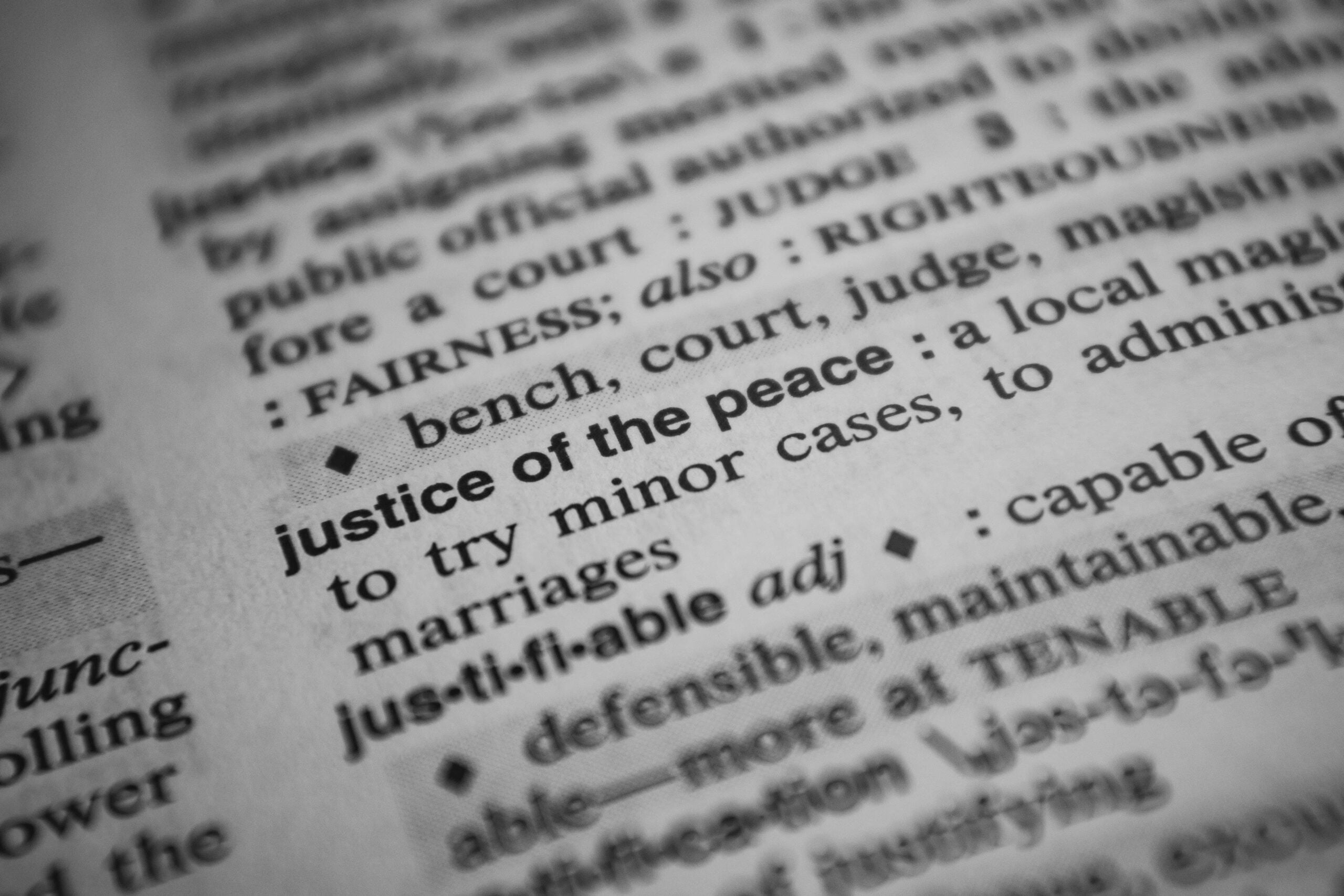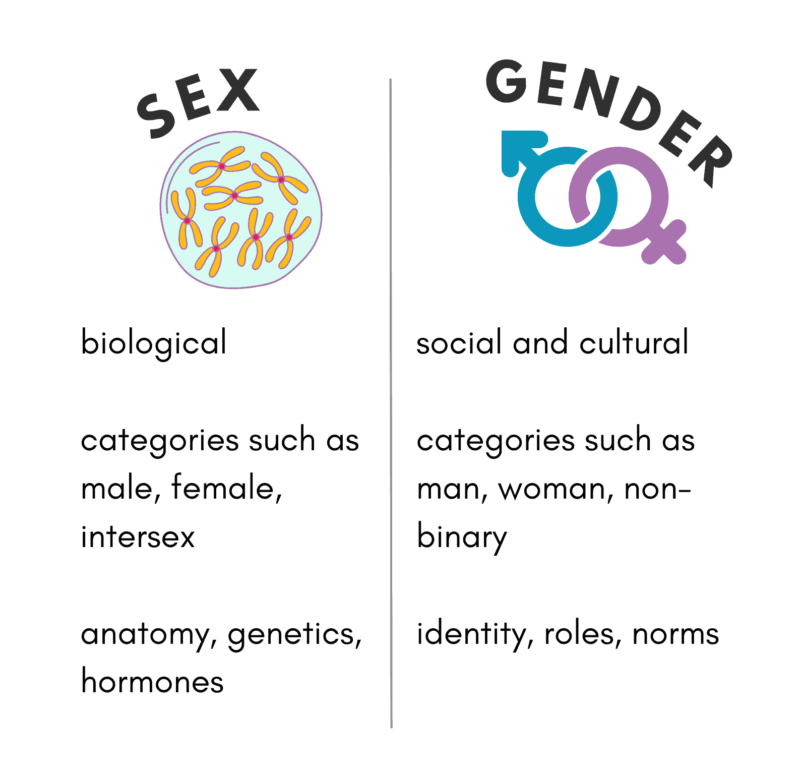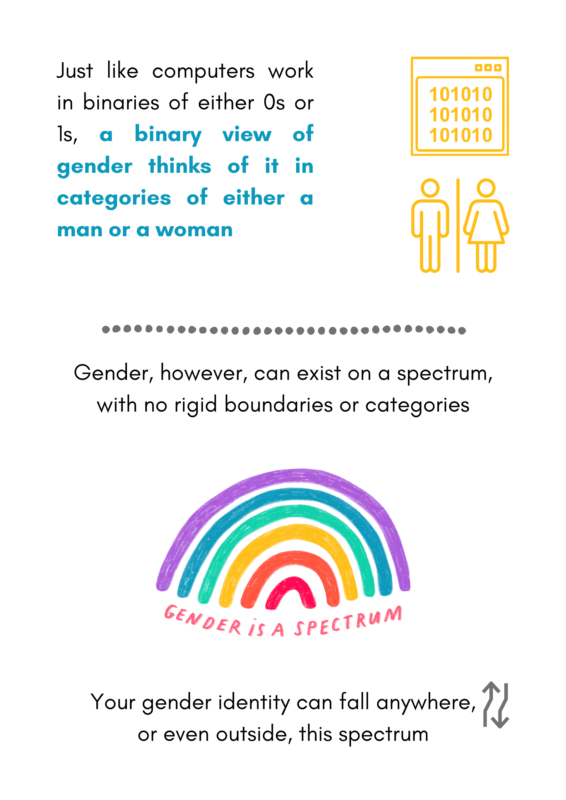ResourcesArticle
Glossary for Gender Sensitisation

DESCRIPTION: A LIST OF TERMS TO UNDERSTAND GENDER, GENDER BASED VIOLENCE, AND DISCRIMINATION.
I. Terms Related to Gender Identity
1. Biological Sex
Biological sex can be male, female, or intersex. People’s sex depends on their genetics, hormones, internal and external body parts, and chromosomes. Intersex people have a mix of male and female biological traits. Sex is a medically important category. However, societal attitudes towards sex differences can sometimes be discriminatory. For example, medical research about female bodies is often given less resources and attention.
2. Intersex
A term used to describe people born with physical, genetic, or hormonal traits that do not fit typical definitions of male or female.
3. Gender and Gender Identity
We do not know the chromosomal or genetic makeup of strangers we meet on the street. Yet, we categorise them as ‘man,’ ‘woman,’ or ‘non-binary’ based on their hairstyle, clothes, the pitch of their voice, and their body language. This is gender. People are conditioned to immediately guess or assume people’s gender but our guesses can sometimes be incorrect.
Every person experiences and expresses gender differently. For example, some women may feel more connected to their femininity when they wear heels and makeup; others might feel more comfortable in shirts and pants. For some women, their clothes may not be connected to their experience of their gender. We may not know how people feel until we ask them. 
4. Cisgender
A person whose gender identity aligns with the sex assigned to them at birth is cisgender.
5. Transgender
A person whose gender identity differs from the sex assigned to them at birth is transgender.
6. Gender Binary
The concept that there are only two distinct and opposite genders (man and woman) is called the gender binary. This forces everyone to conform to either of these categories and excludes anyone who is in between or outside of this binary.
7. Gender Spectrum
Instead of seeing gender as one category (man) versus another category (woman), gender can also be seen as the many shades in between. The idea of gender as a spectrum acknowledges and includes the diversity of gender experiences.

8. Non-binary
‘Non-binary’ is a gender identity. People who are neither men nor women, and thus do not fall within the gender binary, are non-binary. ‘Non-binary’ is a blanket term, which means that it can include various identities such as genderfluid, gender-queer, agender, or third gender communities. Each of these identities may experience gender differently; while some non-binary people may identify as a mix of male and female genders, others may identify as having no gender at all.
9. Gender Fluid
This is a gender identity that may change or shift over time, and does not align with a fixed gender category. People who identify as gender fluid may experience their gender identity as being flexible and not fixed to a single gender. For example, some genderfluid people feel like a man sometimes and a woman other times.
10. Gender pronouns
Everybody uses personal pronouns, and pronouns are often gendered. Women use the pronoun ‘she.’ Men use the pronoun ‘he.’ Non-binary people sometimes use the pronoun ‘they.’ If you are unsure about someone’s gender, you may be unsure of which pronoun to use for them. It’s perfectly okay to ask them what pronouns they use, or use gender-neutral language (like ‘they’) until you have more information.
11. Gender Dysphoria
Some people may experience discomfort when their gender identity does not match the sex they are assigned at birth. This is called gender dysphoria. It is important to note that not all transgender people experience gender dysphoria.
12. Gender Neutral
Anything that is not specifically associated with a particular gender. Any term or concept that does not favour or exclude any gender, and is inclusive of people of all gender identities is gender neutral. Gender neutral washrooms, clothing, and language are some examples.
13. Gender Socialisation
This is the process by which children are taught to behave as a boy or a girl. Gender socialisation also introduces children to gender roles or the roles that each gender is supposed to play, and gender norms or what is considered normal for one gender. For instance, the compulsion for men to be breadwinners and women to be homemakers comes from gender roles. Similarly, the norm that girls should be obedient and boys should not cry are examples of gender norms. Parents, teachers, peers, media, and books are some of the many agents of gender socialisation.
14. Gender Stereotypes
Oversimplified and generalised ideas about the characteristics, behaviours, and roles of individuals based on their gender. They are thought to apply to the entire group, even if examples disproving them exist. “Women make bad leaders” or “men are better at physical tasks” are some examples.
15. Gender Sensitisation
The process of raising awareness and creating an understanding of gender issues to promote gender equality and eliminate discrimination and bias. Including topics about gender in school syllabi, conducting awareness workshops, and creating gender-inclusive policies are all examples of gender sensitisation.
II. Terms Related to Sexual Orientation
16. Sexual Orientation
This is a term that describes who a person is romantic or sexually attracted to. Heterosexual/straight people are romantically and sexually attracted to people of the opposite gender.
17. LGBTQIA+
An umbrella term representing lesbian, gay, bisexual, transgender, queer, intersex, asexual, and other sexual orientations and gender identities. People can choose how to label themselves, and people with similar experiences may use different labels. For example, people who are attracted to more than one gender may identify as gay, queer, or bisexual, depending on their preference.
18. Ally
A person who supports and advocates for the rights and well-being of the LGBTQIA+ community, even if they do not personally identify as a member of the group.
19. Asexuality
Some people do not feel sexually attracted to any gender. Some people can only feel sexual attraction/the desire to have sex under specific circumstances, such as when they have an emotional bond with someone. A sexual orientation defined by a reduced level of sexual attraction, or a lack of sexual attraction towards all genders, is called asexuality.
20. Monogamy
An exclusive romantic or sexual relationship between two people is called monogamy.
21. Polyamory
A form of non-monogamous relationship in which people have multiple consensual partners (romantic, sexual, and/or queerplatonic) simultaneously.
22. Queerplatonic
When we think of relationships, we often think of romantic or platonic ones. Queerplatonic relationships go beyond these categories. They involve a deep, emotional connection, which can look like commitment to each other, sharing of life responsibilities, and a level of closeness typically associated with romantic relationships. Unlike romantic relationships, however, they do not necessarily involve romantic or sexual feelings. The term is often used within asexual and aromantic communities.
23. Heteronormativity
Heteronormativity is the assumption that heterosexuality/being straight is the norm and that other sexual orientations are abnormal. It is the expectation that everyone is heterosexual until they “come out” as gay. As a result, there is no expectation for people to “come out” as straight; a heteronormative society assumes by default that everyone is heterosexual.
24. Queer
This is a blanket term to define sexual orientations and gender identities that do not fit the mainstream category of cisgender and heterosexual. Some LGBTQIA+ people may use the label of queer if they don’t want to define their gender or sexual orientation, or if they are still figuring out their gender or sexual orientation.
25. Questioning
When an individual is said to be “questioning,” they are exploring their sexual orientation, gender identity, or both. Understanding where one fits within the vast and vibrant LGBTQ+ spectrum is often not a linear process. As people question, they engage in the process of self-discovery, trying to understand and define their feelings, attractions, or sense of identity.
26. Coming Out
This is the process through which LGBTQIA+ people tell other people about their sexual orientation or gender identity, often to friends, family, or the broader community. The experience of coming out is uniquely personal and the decision should be made entirely on one’s own terms.
III. Terms Related to Gender Discrimination and Violence
27. Discrimination
This is when someone is treated unfairly or differently based on aspects of their identity such as race, gender, age, or religion. When discrimination against one group has continued for centuries, such as women in patriarchal societies, or people of colour in white supremacist cultures, the discrimination is structural.
28. Institutional Discrimination
When an individual experiences discrimination on an institutional level (as opposed to by one individual) based on characteristics such as gender, caste, or sexual orientation, it is called institutional discrimination. This may look like women being paid less than men for the same jobs, the criminalisation of the LGBTQ+ community, or girls not being permitted to go to school.
29. Marginalisation
This is the process by which individuals or groups are pushed to the edges or ‘margins’ of society when they are denied access to resources, opportunities, and decision-making power based on factors like gender, sexual orientation, race, caste, or other identity markers. Minority groups like transgender communities often face marginalisation in the form of unequal opportunities for work, limited access to formal financing, and a lack of safe healthcare. Marginalisation maintains harmful hierarchies present in society.
30. Misogyny
Dislike or contempt towards people and things that appear to be feminine is called misogyny. Discrimination against people who look feminine, regardless of whether they identify as a man, a woman, or a non-binary person, is misogyny. That is why, homophobia towards gay men is driven by misogyny. Telling boys that they shouldn’t cry, express their feelings, or perform activities associated with women like cooking or dancing, is also driven by misogyny because it is a dislike towards roles that are labelled feminine.
31. Homophobia
Bias or discrimination against people of the LGBTQ community is called homophobia. It can come in various forms, ranging from discrimination and bias to verbal or physical abuse.
32. Transphobia
Bias or discrimination against transgender and non-binary people is called transphobia. Sometimes, people say that they support gay, lesbian, and bisexual individuals, or people with non-straight sexual orientations, but do not support people with non-cis gender identities. This is because representation, understanding, and acceptance of different sexual orientations is more prevalent in some cultures than that of gender identity. Eradicating transphobia is important for the wellbeing of transgender and non-binary people.
33. Patriarchy
A type of society where all power resides with the men in a family. Men in comparison to women often have greater control and authority in such a society. This can look like more men in political leadership, only permitting sons to pursue higher education, or gendered pay disparity.
34. Gender-based Violence (GBV)
Any physical, emotional, psychological, and/or sexual harm committed against a person because of their gender. Women and trans people are often more likely to face GBV. Online harassment is also GBV.
35. Coercion
Using pressure, manipulation, or force to make someone agree to an action or decision against their will. It is a violation of consent and boundaries. Any consent taken using coercion is not really consent.
IV. Terms Related to Safety, Equality, and Health
36. Intersectional Feminism
A social movement that works towards the ideal that everyone, regardless of their gender, caste, race, religion, and other intersections of identity should have the same rights, opportunities, and treatment in all aspects of life. It recognises that people may face discrimination in some ways while having privilege in others. For example, an upper-caste woman may face discrimination based on her gender while having caste privilege. Some people may face discrimination on multiple levels such as a lesbian woman experiencing discrimination because of her gender and sexual orientation.
37. Consent
Consent is voluntary, clear, and enthusiastic agreement to engage in a particular activity. It is often associated with sexual intercourse but actually applies to many aspects of relationships. Even to start a romantic relationship, you need the consent of the other person. Consent should not be assumed. If there is ever a doubt whether the other person is enthusiastically participating in a sexual or non-sexual activity, just ask. Consent given for one activity does not apply for others. For example, a person consenting to being in a relationship is not automatically consenting to sexual activity.
38. Boundaries
Personal limits or guidelines that a person creates to define what feels safe, acceptable, and comfortable to them in their interactions, relationships, and personal space.